A
story from the life of the SS Great Britain now restored and an award winning
museum in Bristol, England |
THE
SALVAGE OF THE GREAT BRITAIN - FALKLAND ISANDS 1970 |
The
HMS Exeter Connection |
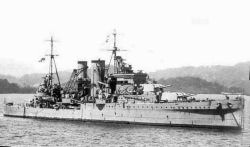 | HMS
Exeter was a York class heavy cruiser of the British Royal Navy which played
a major rôle in the first important sea battle of the Second World war.The
Exeter instantly became the icon for the bravery and determination of the
British Armed forces.The Exeter was was laid down on 1st August 1928 at
the Devonport Dockyard, Plymouth, Devon,England - 8,390 tons displacement, maximum
speed just over 33 knots, [30k/p/h and a range of 10,000nm [18,000km] The Exeter
was well armed and in 1939 also carried a catapult-launched sea-plane. | |
| HMS
Exeter [HMS = His Majesty's Ship] | On
the right - damaged in the Falkland Islands -December 1939 |
| In
1939 at the beginning of the war the Exeter was stationed in the south
Atlantic with two smaller cruisers Ajax and Achilles with the mission
to destroy German navy ships - the notorious 'surface raiders' attacking British
merchant shipping. Number one on the list was the pocket- battleship Admiral
Graf Spee. In December 1939 Exeter was in Port Stanley in the Falkland
Islands when news of a sighting arrived by radio. Exeter went north to
join what became known as he Battle of the River Plate. The rest is history. But
less well known is the Exeter's touch-and-go return to the Falkland Islands,
here digitally, and documented at the time is the account by Sir Herbert Henniker
Heaton the Island's Governor. |
The
Governor of the Falkland Islands leaked the story to the London Evening Standard
- READ THE ORIGINAL |
| Velma
- the Islander who remembered | 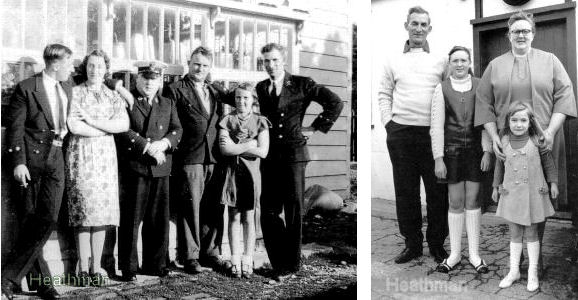 The
Governor's story tells us how badly the Exeter was damaged and how the
the ship limped back to the safety of Port Stanley. 61 sailors died and many were
injured. The
Governor's story tells us how badly the Exeter was damaged and how the
the ship limped back to the safety of Port Stanley. 61 sailors died and many were
injured.
The
condition of the Exeter was so grim that most of the survivors were billeted
[given accomodation] with Island families. In the 1930s Stanley did not
have an hotel or bed and breakfast or any restaurant / cafe. The main bar or 'pub
was the 'Stanley Arms' run by Axel Pettersson the son of a Swedish sailor who
had been shipwrecked on the Islands. Axel
took in some of the Exeter's crew including Chief Petty Officer - shipwright
Leslie O'Neil knicknamed 'Spike' who was largely responsible for getting the
Exeter to a point where it was sea-worthy and able to return to Devonport. In
the picture on the far left Spike in his Royal Navy kit is next to Axel's nine
year old daughter Velma. Then in 1970 Spike is with Velma - on the right. |
|
|
Leslie 'Spike' O'Neil - The Man who
gave the 'OK' to salvage the 'Great Britain' | 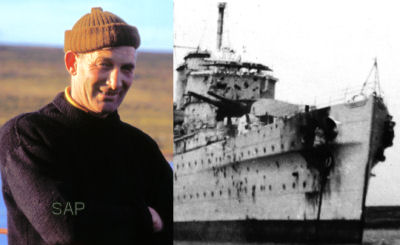 Velma
wrote the account of the reunion in her unpublished 'book' of memoirs titled -
'As Ignorant as Sheep'. Velma heard Spike's name on the Island Radio in
January 1970 when the list of passengers due to arrive on RMS Darwin was
announced . The Darwin plied monthly between Stanley and Montevideo, Uruguay
- the South American mainland. Velma
wrote the account of the reunion in her unpublished 'book' of memoirs titled -
'As Ignorant as Sheep'. Velma heard Spike's name on the Island Radio in
January 1970 when the list of passengers due to arrive on RMS Darwin was
announced . The Darwin plied monthly between Stanley and Montevideo, Uruguay
- the South American mainland.
Just
before the Darwin arrived in Stanley, Velma received a telegram from Spike
saying 'I'm coming to stay with you if that is alright..Spike ' She wondered
what it was about. After
the second world war, Spike had taken a job with the well established marine  salvage
company Risdon Beazley based in Southampton, England. To his colleagues he was
known as 'Bill' and outside usually as Leslie - a man of few but very sound words.
Leslie O'Neil's second visit to the Falkland Islands came when his expert advice
was essential to save the Great Britain. salvage
company Risdon Beazley based in Southampton, England. To his colleagues he was
known as 'Bill' and outside usually as Leslie - a man of few but very sound words.
Leslie O'Neil's second visit to the Falkland Islands came when his expert advice
was essential to save the Great Britain. The
Great Britain was a very rusted hulk almost breaking in half on a beach.
The the first salvage company approached to do the job simply said it was an impossible
risk to take. But Risdon Beazley had different ideas thanks to their association
with the German salvors Ulrich Harms and Spike was asked to make an assessment.
The money was in place, Harms had a massive Mulus pontoon within range and a team
of divers was ready to go. In January 1970 Spike looked at the wreck and said
' OK -- it can be done' and by April 24th the 'Britain' was on the way
back to Bristol. | | MORE
on this story in the book Saving the Great Britain |
|
|
WAS
IRON FROM THE GREAT BRITAIN TAKEN TO REPAIR HMS EXETER? | 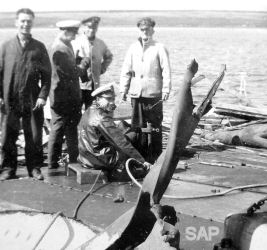 | The
age of the internet has spread a story about iron plates from the Great Britain
being used by shipwrights to repair HMS Exeter when the ship was in Stanley
Harbour after the battle. Some accounts even came from Exeter veterans
though the facts do not support the memories. The
picture on the right came from a Falkland Islands family involved with the repairs
and it reveals good steel being used on the deck - from personal experience clearly
this is not metal from the Great Britain. It does not prove that
the old Great Britain iron was not used elsewhere but from the available
evidence it seems unlikely. | | A
note from Tony Morrison looks at the evidence | Royal
Navy and local shipwrights fit new steel plating to the deck of HMS Exeter -1939 |
|
| Special
thanks for information and photos:- to Leona Roberts/ Falkland Islands Museum,
Stanley. Ailsa Heathman and Noeline Sloggie - neé Biggs, Stuart Whatley,
Lyle Craigie Halkett, the late Leslie 'Spike' O'Neil,.Lynn Bruce and to the National
Archives, Kew, Surrey, England |

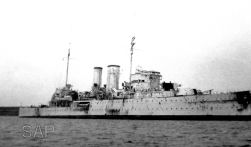
 The
Governor's story tells us how badly the Exeter was damaged and how the
the ship limped back to the safety of Port Stanley. 61 sailors died and many were
injured.
The
Governor's story tells us how badly the Exeter was damaged and how the
the ship limped back to the safety of Port Stanley. 61 sailors died and many were
injured. Velma
wrote the account of the reunion in her unpublished 'book' of memoirs titled -
'As Ignorant as Sheep'. Velma heard Spike's name on the Island Radio in
January 1970 when the list of passengers due to arrive on RMS Darwin was
announced . The Darwin plied monthly between Stanley and Montevideo, Uruguay
- the South American mainland.
Velma
wrote the account of the reunion in her unpublished 'book' of memoirs titled -
'As Ignorant as Sheep'. Velma heard Spike's name on the Island Radio in
January 1970 when the list of passengers due to arrive on RMS Darwin was
announced . The Darwin plied monthly between Stanley and Montevideo, Uruguay
- the South American mainland.  salvage
company Risdon Beazley based in Southampton, England. To his colleagues he was
known as 'Bill' and outside usually as Leslie - a man of few but very sound words.
Leslie O'Neil's second visit to the Falkland Islands came when his expert advice
was essential to save the Great Britain.
salvage
company Risdon Beazley based in Southampton, England. To his colleagues he was
known as 'Bill' and outside usually as Leslie - a man of few but very sound words.
Leslie O'Neil's second visit to the Falkland Islands came when his expert advice
was essential to save the Great Britain.